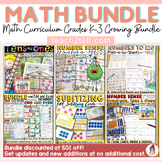57 results
High school applied math laboratories for Microsoft Word

Penny Boat Lab: Density, Buoyancy and Archimedes
This is a one period activity/lab to teach students about the concept of density and Archimedes Principle, why things float. Students each get a piece of aluminum foil and design and make a boat. They then must calculate how many pennies it will carry before sinking, and then test it. This is an excellent one day STEM project that combines science, math, design and construction. Students will use the formula Density=Mass divided by Volume.
Grades:
7th - 10th
Types:
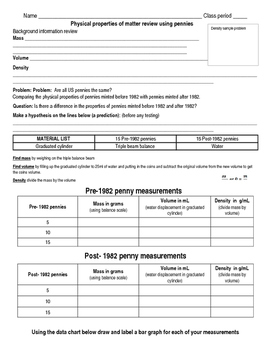
Physical properties of matter review using pennies Mass, Volume, and Density Lab
Physical properties of matter review using pennies to find mass, density, and volume.
Supplies
You will need many pennies for this lab
15 each of 1981 and older ones and 1983 and newer ones per group.
Triple balance beam per group or a central few
Small graduated cylinder approximately 50mL
I did this with my 6th grade science class, it give them a hands on comparison that density is different from volume and that density of the same materials stays the same no matter the weight.
Stu
Subjects:
Grades:
6th - 12th
Types:

Lab Activity Calculating Rates of Tectonic Plate Motion
In this activity students will calculate the rate of the movement of Pacific Tectonic plate by examinining the formation of Hawaiian island chain. Students begin by determining ages of rocks found on each island using radiometric dating principle. Then they use scale maps to determine real world distances between islands. Finally they determine speed of motion from distance and time passed.
This lab utilizes the claim, evidence and reasoning framework to guide students to synthesis of ideas and
Subjects:
Grades:
8th - 12th, Higher Education
Types:

Analyzing a Vertical Jump: Kinematics Lab Activity
This hands-on laboratory activity challenges your students to apply their understanding of kinematic elements and equations to complete an analysis of a simple motion scenario: a human jumping vertically.This activity can be used as an engaging skills practice or formative assessment depending on the needs of your 7th - 12th grade science students.This digital resource includes:Teacher's Guide: outlines suggested laboratory protocols, tips for implementation, and possible methods of document dis
Subjects:
Grades:
7th - 12th
Types:
NGSS:
HS-PS2-2
, HS-PS2-1
, HS-PS2-4
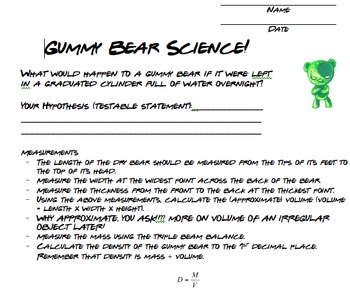
Gummy bear lab/ hypothesis, object volume, graph interpretation lab
This interactive lab for middle school and high school students teaches students how to create a correct hypothesis, prove or disprove the hypothesis using the scientific method, correct use of lab tools like graduated cylinders, triple beam balances, how to calculate density, and how to read and understand data charts. The lab uses the properties of gummy bears to teach these Key concepts. This lab can be used in its entirety over four class periods or can be broken into four separate smaller l
Subjects:
Grades:
6th - 9th
Types:
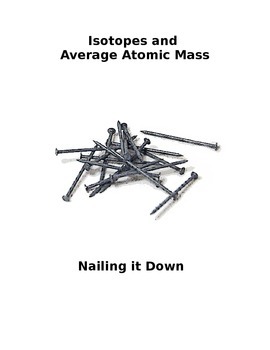
Isotopes and Average Atomic Mass
The fictional element, nailonite, is central to this inexpensive laboratory activity. Other than a balance, the only material required for this activity is a sample of 10-25 total nails of three different sizes for each lab group. Each nail in the sample represents one of the three isotopes of the element. This simulation allows students to actually measure the mass of each of the three isotopes, and, after calculating the relative abundance of the isotopes in the sample, calculate the average a
Subjects:
Grades:
9th - 12th
Types:

Projectile Motion Bullseye Virtual lab! Inquiry based investigation
Can you hit the bullseye? Students love this inquiry based activity on Projectile Motion. Use the Phet Projectile Motion Interactive to investigate the variables that impact an objects' projectile motion, such as launch angle, velocity and mass. Students attempt to land their object (they can select from a variety such as a car, pumpkin, person or even a piano!) and then adjust the velocity and height to try and score a perfect bullseye. Once they hit the bullseye, they receive 3 stars. Who
Subjects:
Grades:
9th - 12th
Types:
NGSS:
HS-PS2-1

Science 10: Velocity and Acceleration lab
The lab:Students will measure velocity of cars going down ramps and then calculate their acceleration, then will take measurements for density and mass to determine if any had an affect on the speed of the cars.In this lab you will need toy cars and ramps, I found that using 0.6m intervals was about right with the ramp set up but you can make them shorter or longer on your needs. I used the following Tracks from amazon:https://www.amazon.ca/Hot-Wheels-Builder-Unlimited-HFD00/dp/B09PGY8M5Z/ref=sr
Subjects:
Grades:
9th - 11th
Types:
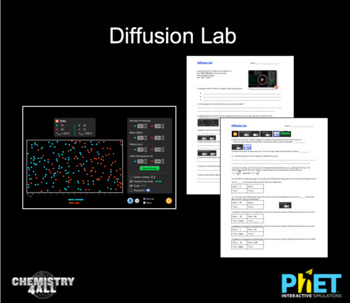
PhET Diffusion Lab
Made For Distance Learning:This lab is 1 of aset of 10, which was made to pair with freePhET online simulations, which allow hands on engagement in a distance learning setting. Chromebook and tablet accessible. Simply upload to google classroom. Make a student copy and let students fill in. Answer Key Included (So copy paste in a safe space :) Lab Objectives: Students will find that rate of diffusion is dependent on both temperature and mass. Students will use Graham's Law to better analyze re
Subjects:
Grades:
9th - 11th
Types:
Also included in: PhET Chemistry Labs Series
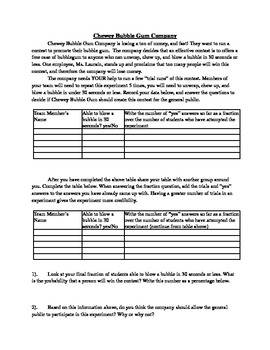
Chewey Bubble Gum Company - Intro To Probability
Want to introduce your students to the probability of something happening? Want to peak their interest before you start a probability unit? This experiment based activity allows students to find the probability of something happening while having fun and popping bubble gum bubbles!
Subjects:
Grades:
6th - 12th
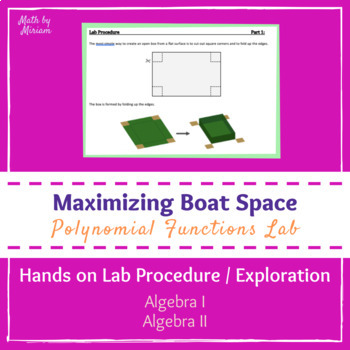
Introduction to Polynomials Functions Lab (PBL PrBL Activity)
This lab is meant to launch your Polynomials unit in an Algebra 2 class or an Honors Algebra 1 class. This is a perfect addition to any PrBL/PBL run class. Before teaching students anything, let them explore an application for a polynomial (cubic) function and derive a function themselves. The pre-lab directs students to build an open-face-box out of a single piece of paper with the largest volume possible in any way they choose (do not give them any further directions!). At the end of the pre-l
Subjects:
Grades:
9th - 11th
Types:
CCSS:
Also included in: Polynomial Functions Resource Bundle (PrBL PBL Unit)
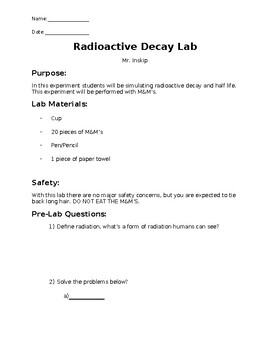
Science Radioactive Decay lab
Radioactive Decay lab using M&Ms to show the half life of the material and to display the decay curve.You will need to buy some candies for this lab but thats it! It is a fun and tasty activity to get students graphing and learning about half-lives!
Subjects:
Grades:
8th - 10th
Types:
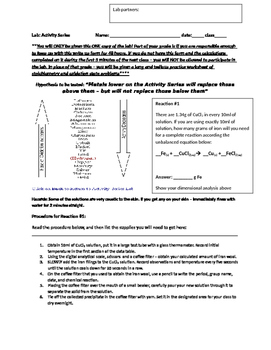
Lab: Testing the Activity Series
This is a multiple concepts lab that has a lot of 'wow' factor for students as metals disappear and new ones appear. It is in miniscale so you that don't use that much of your chemicals. For 250 students, I generally use up: 20 g Fe, three 12"x12" sheets of Al foil, 12" of Mg ribbon, 20g Zn powder, and 200 ml of 1M CuSO4 solution. Equipment: large test tubes, 0.001 accuracy balance, long glass thermometer, small beaker, graduated cylinder, timer (or let them use cell phones)
Concepts covered:
Subjects:
Grades:
10th - 12th, Higher Education
Types:
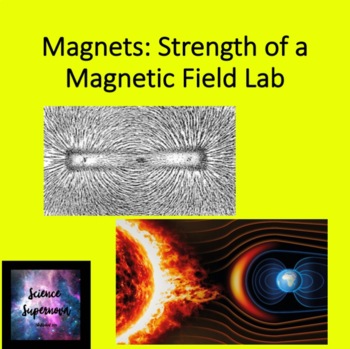
Magnets: Strength of a Magnetic Field Lab
This lab provides students with two separate experiences measuring magnetic strength. One part uses bar magnets and directional compasses and the other part uses ring magnets and washers to measure magnetic fields. The lab is editable.
Subjects:
Grades:
8th - 12th
Types:
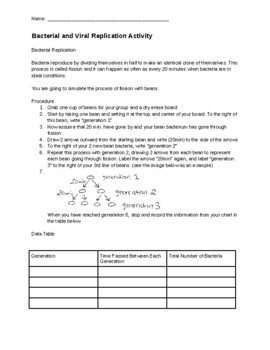
Bacterial and Viral Replication Lab
This lab requires you to have raw beans (any kind to model bacteria) and whiteboards for students to draw a family tree and write out generation numbers next to each bacterial generation. (You could also do this on paper.)This lab is a great way for students to simulate bacterial and viral reproduction. For the bacteria, students will model the number of bacteria in each generation starting with only one bacterium (represented by a bean). With each generation, students will watch as the family t
Subjects:
Grades:
8th - 9th
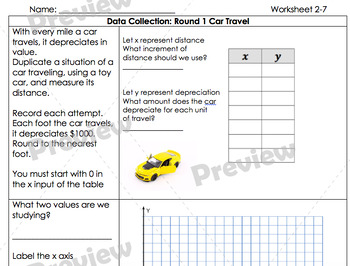
Investigating Linear Graphs
I built this discovery lesson so that students would learn, hands-on, how to build a graph based on data they collected from their own investigation. Materials you will need for this lab include a set of cups that are stackable and several small toy cars. For this task you will need:Toy carsCupsMarshmallows
Subjects:
Grades:
6th - 9th
Types:

Corsage & Boutonniere Lab
Corsage & Boutonniere Lab Instructions and Itemized Bill worksheet.
Grades:
6th - 12th, Higher Education, Adult Education
Types:
Also included in: Collection of Floral Design Labs
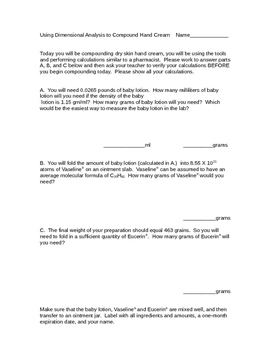
Dimensional Analysis Purposeful Lab: Making Hand Cream
Designed for a middle school or first year chemistry student, yet even my older students really seemed to enjoy it!
Students perform dimensional analysis calculations to determine the amount of each constituent needed to make a hand cream which they compound and then take home! Designed by pharmacists to mimic what pharmacists might actually do as well as hone those dimensional analysis (factor label) calculation skills in students!
Labels for the hand cream are included. A one month expiratio
Subjects:
Grades:
7th - 12th
Types:
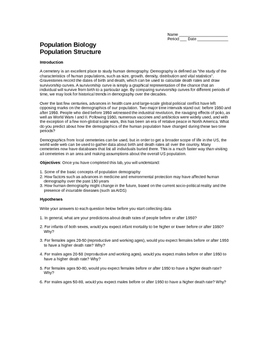
Human Population: Cemetery Population Structures
The American population is changing in dramatic ways. Likewise, changing population structures in other countries are driving changes around the world. Food supplies, energy use, climate change: all are consequences of the changing structures of world populations.
This activity belongs to a 3-part collection for a week-long population structure investigation using free Internet resources. Be sure to download my PopulationStructure PowerPoint and PopStructureData Excel spreadsheet. The lab se
Subjects:
Grades:
8th - 12th, Higher Education

Theoretical vs. Experimental Probability
This is a dice activity that helps the students see the difference in theoretical and experimental probability.
Subjects:
Grades:
6th - 12th
Types:

Surface Area & Volume of Oblique Prisms: Student Investigation
In this investigation, students will use raw spaghetti and mini marshmallows to discover how the surface area and volume of a prism relate to the surface area and volume of the respective oblique prism. Students will be asked to create a rectangular prism using marshmallows to connect the vertices. Using a ruler, they will measure the dimensions of the prism, calculate and record the surface area and volume. Then they will make their prism into an OBLIQUE prism by giving it a slight push to t
Subjects:
Grades:
6th - 10th
Types:
CCSS:
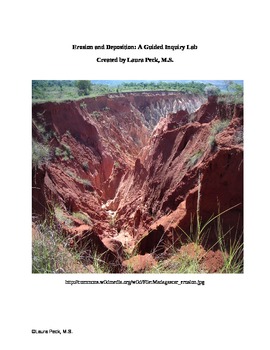
Erosion and Deposition: A Guided Inquiry Lab
This is a two part laboratory activity where students must create a hypothesis to test, design an experiment and then see if the experimental results support or refute their hypothesis. This lab incorporates application mathematics with the scientific method and critical thinking skills within the Earth science content. Suitable for upper level middle school to inclusion high school students.
Material cost should be under $5. The disposable materials can found around the yard. Very safe! The b
Subjects:
Grades:
6th - 10th
Types:

Scale of Solar System Activities - Make a Necklace or Giant Model!
Looking for an engaging and accurate way for students to model our solar system?Most models of our solar system are not accurate and show our sun and 8 planets orbiting very closely together. Students will make a necklace that shows a more accurate scale of the solar system! This math-meets-science cross curricular activity is a fun and enlightening way for students to see the scale of our solar system. Students will learn about ratios and calculating with decimals. Sample calculations are provi
Subjects:
Grades:
5th - 9th
Types:

Math Lab: Slope
Students create cardboard "ramps" with various rise and run values for toy cars. Students then record data on a lab sheet and answer reflection questions.
Subjects:
Grades:
7th - 10th
Types:
Showing 1-24 of 57 results




